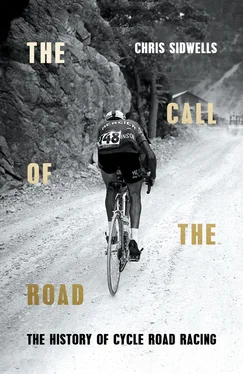1 ...6 7 8 10 11 12 ...22 However, it did not have the most auspicious start. Many entrants for the first edition had never seen the roads of the north, and when word spread about Breyer’s ride, and especially as there was a lot of rain just before the race, half the field didn’t start. The professional riders were all there, though, with their eye on the big first prize. Professionals were allowed to use pacers, some riding tandems, to help them, and the field soon split up across the rolling roads of Picardie. Even a lot of the roads in Picardie were cobbled, and the cobbles and weather conditions grew worse as the riders went further north.
The reason they were worse, and the reason why there were so many cobbled roads in the first place, was that the north was the heart of heavy industry in France. Hundreds of coal mines, steel mills and factories, often barely 100 metres apart, belched fire and filth across the countryside. Mining subsidence buckled the roads and warped the houses, while heavy carts lifted loose stones and spread mud and coal dust wherever they went.
Josef Fischer of Germany won the race in a time of 9 hours and 17 minutes, which is an average speed of 30.162 kph (18.742 mph). He entered the Roubaix velodrome 25 minutes ahead of the next rider, Charles Meyer of Denmark. And when Fischer arrived, the crowd, who were enjoying some track racing while being informed of the progress of Paris–Roubaix, were shocked by his appearance. He was covered from head to foot in coal dust and mud from the roads, and with dried blood from his frequent crashes.
Apart from Meyer, only two other riders finished within an hour of Fischer. The first of them was Maurice Garin, who would win Paris–Roubaix the following year and again in 1898; the other rider was a Welshman called Arthur Linton; and both would continue to feature in the story of early road racing.
Once he’d cleaned off the mud and muck, Fischer was remarkably casual about his victory. ‘The race was quite easy for me,’ he told reporters. ‘You must be strong to ride so far over cobblestones, and I am strong. I know that about myself.’ Given his domination, and how seemingly straightforward it was for Fischer to win, it’s incredible that Germany had to wait 119 years for its next Paris–Roubaix winner, which was John Degenkolb in 2015.
Promoting and/or organising road races helped make the names of many newspapers and periodicals, but it also saw an intense rivalry grow between them. A rivalry that had them trying to outdo each other with longer, bigger and more attention-grabbing races. This inter-publication war moved the sport along, and it helped write the next page in the history of road racing, with the creation of the biggest road race in the world: the Tour de France.
By 1894 Le Vélo , the newspaper that organised the first Paris–Roubaix, was the leading cycling journal in France. It had an advantage over its rivals because as well as carrying news it was also the official voice of the governing body of French cycling. Le Vélo published the locations and start times of all official races in France, so cyclists and cycling fans alike needed to buy it, to read race reports and interviews, and to find out where future races were being held.
Everything was looking good for Le Vélo . Even if some advertisers grumbled when the newspaper hiked its ad prices up, it didn’t affect their need to be seen in its pages. Then, just when it looked like Le Vélo had French cycling sewn up, its editor Pierre Giffard got involved in something outside of the sport that ended up costing his newspaper dearly. It was the Dreyfus affair, a cause célèbre in which a Jewish army officer called Alfred Dreyfus was framed for treason by a section of the French military and was convicted in 1895 on very dubious evidence.
Dreyfus was sent to the French penal colony, Devil‘s Island. His Jewish heritage and the fact that he was born in Mulhouse in Alsace, which was then part of Germany having been won during the 1870 Franco-Prussian War, were accepted as evidence that he had passed French military secrets to the Germans. Somebody had done so; there was no doubt about that, but no direct evidence implicating Dreyfus.
There was public disquiet, and even some of the French Army didn’t believe in his guilt. One officer, Lieutenant-Colonel Picquart, conducted his own investigation, and he came up with credible evidence that the real traitor was a Major Ferdinand Esterhazy. The French high command wouldn’t listen, and Picquart was transferred to Tunisia to keep him quiet, but the questions he and others raised wouldn’t go away. Reports of a cover-up started appearing in the French press.
A campaign led by artists and intellectuals, including the novelist Emile Zola, gathered strength and eventually won a pardon for Dreyfus in 1899, but the case stirred deep emotions. It was a massive talking point in France, with everybody having a view. There were some very public arguments and demonstrations on both sides. At one protest an influential backer of Le Vélo , the Count de Dion, was arrested. He was demonstrating against the campaign to pardon Dreyfus, and was alleged to have hit the President of France, Emile Loubet, on the head with a walking stick he was waving about to emphasise his point.
Le Vélo ’s editor Giffard was pro-Dreyfus, and had high principles. Putting principle before business, he criticised De Dion in an article he wrote for a serious newspaper, Le Petit Journal . De Dion was outraged, and even though he was imprisoned when word of what Giffard had written reached him, he withdrew his support for Le Vélo as well as all of the money he’d invested in it. Then, still unhappy, De Dion went further.
When he was released from prison after a fifteen-day sentence in 1900, De Dion formed his own sports newspaper, which he called L’Auto-Vélo . It was funded by his businesses, and by those of his friends who either sympathised with his views or were unhappy with Le Vélo ’s advertising rates. They included Edouard Michelin, the biggest tyre manufacturer in France.
The new venture needed an editor, and De Dion went for somebody young and ambitious who knew about cycling. He was Henri Desgrange, a 35-year-old former racer who ran the biggest velodrome in Paris, the Parc des Princes. Desgrange had a law degree, and had started his working life practising law, but he was too adventurous to spend his life in fusty courts arguing arcane cases. He was a racer first and a lawyer second, and he came unstuck when one of his employer’s clients saw Desgrange speeding around a Paris park with his calves exposed. The client complained to Desgrange’s boss, who promptly sacked him.
So Desgrange changed careers, quickly becoming the head of advertising for the tyre manufacturer, Clément et Cie. He continued racing, setting the first official World Hour Record in 1895, riding a distance of 35.325 kilometres on the Vélodrome Buffalo in Paris. There had been unofficial hour records before. James Moore rode 23.2 kilometres in 1873, and Frank Dobbs did 29.552 in 1876, but Desgrange’s hour was the first recognised by the then governing body of world cycling, the International Cycling Association.
While working in advertising, Desgrange wrote articles about cycling for various newspapers, including Le Vélo . He also wrote a best-selling book on training called The Head and the Legs . By the time Desgrange left advertising to run the Parc des Princes he had a big following in French cycling, and influential friends. De Dion chose well.
It was 1900, the beginning of a new century, but starting a new publication is never easy even when there are good reasons to do so. Giffard and Le Vélo were in a very strong position. As well as the backing of the French Cycling Federation, Le Vélo still had a lot of advertisers because Giffard only put up rates for De Dion’s associates. And Giffard held the moral high ground because of his stand over Dreyfus.
Читать дальше












